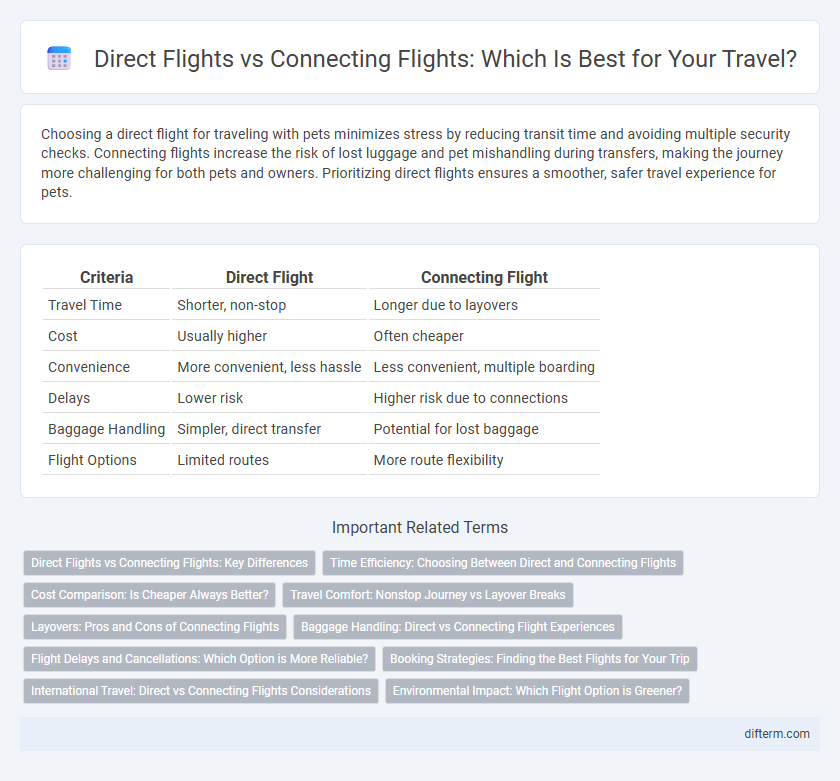Choosing a direct flight for traveling with pets minimizes stress by reducing transit time and avoiding multiple security checks. Connecting flights increase the risk of lost luggage and pet mishandling during transfers, making the journey more challenging for both pets and owners. Prioritizing direct flights ensures a smoother, safer travel experience for pets.
Table of Comparison
| Criteria | Direct Flight | Connecting Flight |
|---|---|---|
| Travel Time | Shorter, non-stop | Longer due to layovers |
| Cost | Usually higher | Often cheaper |
| Convenience | More convenient, less hassle | Less convenient, multiple boarding |
| Delays | Lower risk | Higher risk due to connections |
| Baggage Handling | Simpler, direct transfer | Potential for lost baggage |
| Flight Options | Limited routes | More route flexibility |
Direct Flights vs Connecting Flights: Key Differences
Direct flights offer a faster travel time by avoiding layovers, reducing overall journey duration and minimizing the risk of missed connections or delays. Connecting flights often provide more route options and can be cheaper but may increase travel time and the chance of luggage mishandling or flight disruptions. Choosing between direct and connecting flights depends on priorities like convenience, budget, and destination availability.
Time Efficiency: Choosing Between Direct and Connecting Flights
Direct flights save travelers valuable time by eliminating layovers, often reducing total travel duration by several hours compared to connecting flights. Connecting flights may offer cost savings but increase overall trip time due to layover waits and potential delays. Travelers prioritizing time efficiency should opt for direct flights to ensure faster and more convenient journeys.
Cost Comparison: Is Cheaper Always Better?
Direct flights often come with higher ticket prices due to convenience and shorter travel times, while connecting flights typically offer lower fares but may involve longer layovers and added travel stress. Cost savings on connecting flights can be offset by expenses such as additional transportation, meals during layovers, and potential missed connections leading to delays. Evaluating the total travel cost beyond ticket price is essential to determine if the cheaper option truly provides better overall value.
Travel Comfort: Nonstop Journey vs Layover Breaks
Direct flights offer superior travel comfort by eliminating the stress and fatigue associated with layovers, ensuring a seamless and quicker journey. Connecting flights, while potentially less convenient, provide travelers with the opportunity to stretch, refresh, and reduce cabin fatigue during layover breaks. Passengers prioritizing comfort often prefer nonstop flights to minimize total travel time and avoid the hassle of changing planes.
Layovers: Pros and Cons of Connecting Flights
Connecting flights often involve layovers that provide passengers with a chance to stretch, grab meals, or explore airport amenities, offering a break during long journeys. However, layovers can increase total travel time and pose risks of missed connections due to delays. Travelers should weigh the potential cost savings and destination options against the inconvenience and uncertainty of layover periods.
Baggage Handling: Direct vs Connecting Flight Experiences
Baggage handling on direct flights minimizes the risk of lost or delayed luggage, as bags are typically checked through to the final destination without transfers. Connecting flights increase the chances of mishandled baggage due to multiple loading and unloading processes at intermediate airports. Airlines often have stricter baggage transfer protocols on direct routes, enhancing overall luggage security and traveler convenience.
Flight Delays and Cancellations: Which Option is More Reliable?
Direct flights generally offer a higher level of reliability with fewer delays and cancellations compared to connecting flights, as they eliminate the risk of missed connections and reduce overall travel time. Airlines report that direct routes have a delay rate of approximately 15%, while connecting flights experience delays upwards of 25% due to factors compounded by multiple takeoffs and landings. Travelers seeking efficiency and reduced disruption often prefer direct flights for timely arrivals and smoother itineraries.
Booking Strategies: Finding the Best Flights for Your Trip
Booking direct flights often ensures shorter travel times and fewer chances of delays, making them ideal for travelers prioritizing convenience and efficiency. Connecting flights, while potentially cheaper, require careful consideration of layover durations and airport logistics to avoid missed connections and added stress. Utilizing flight comparison tools and flexible date searches helps identify the best balance between cost and travel time, optimizing the overall booking strategy.
International Travel: Direct vs Connecting Flights Considerations
Direct flights minimize travel time and reduce the risk of missed connections, making them ideal for international trips where efficiency and convenience are priorities. Connecting flights often offer more flexible pricing options and can provide access to a broader range of destinations, but they increase total travel duration and the potential for delays. International travelers should weigh factors like layover duration, visa requirements at transit points, and overall travel fatigue when choosing between direct and connecting flights.
Environmental Impact: Which Flight Option is Greener?
Direct flights generate fewer carbon emissions per passenger kilometer compared to connecting flights due to reduced fuel consumption during takeoff and landing phases. Connecting flights require additional takeoff and landing cycles, which significantly increase overall greenhouse gas emissions. Airlines and travelers seeking environmentally friendly options should prioritize direct routes to minimize their carbon footprint.
direct flight vs connecting flight Infographic

 difterm.com
difterm.com